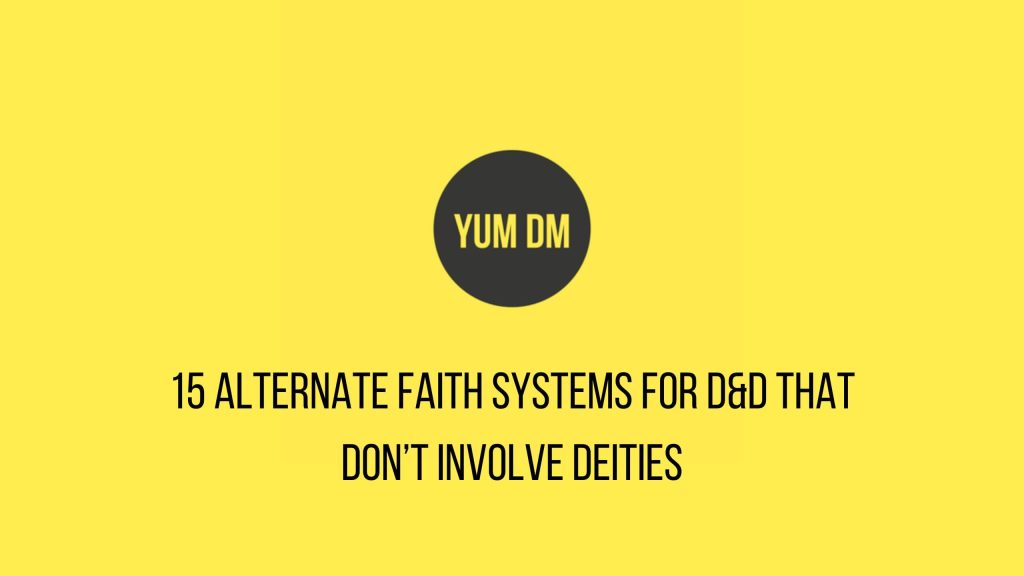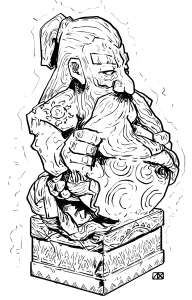
Issue 30 of d12 Monthly, which is focused on deities and demi-gods, did just that: focused on developing a pantheon of gods for your Dungeons & Dragons game.
(I also have blog post that shows how I created my major pantheon as well).
However, there are other faith systems that characters, and whole societies, can worship and base their faith in.
You can use the following 15 alternative faith systems as the basis for your religion, or just use them as different ways various cultures or races (even monstrous ones) practice their faith.
Dwarves in my campaign world of Aythia, for example, worship their ancestors, eschewing typical deities altogether.
While elves worship Nature in all its forms.
You can easily see how other races could worship the elements, various nature spirits, or even themselves.
Faith Systems
Without further ado, here’s a list of potential faith systems that don’t involve deities for your fantasy world.
Animism
The belief that all objects, plants, and animals possess a spirit or soul. This belief system could manifest in various ways, such as reverence for nature, respect for animals, and the use of objects as spiritual tools.
Ancestral Veneration
The veneration or respect of deceased ancestors. This belief system could focus on honouring family traditions, seeking guidance from ancestral spirits, and maintaining a connection with the past.

Cosmicism
The belief in the vastness and indifference of the universe, emphasising the insignificance of humanity in the grand scheme of things. This belief system could lead to a focus on personal fulfilment, acceptance of fate, and a sense of wonder at the mysteries of the cosmos.
Harmonism
The belief in the interconnectedness and balance of all things. This belief system could emphasise living in harmony with nature, respecting the delicate balance of ecosystems, and striving for harmony within oneself and with others.
Stoicism
The philosophy of accepting what cannot be controlled and focusing on what can be controlled. This belief system could stress resilience, self-discipline, and finding virtue in one’s own actions and character.
Naturalism
The belief that all phenomena can be explained by natural causes without the need for supernatural explanations. This belief system could emphasise methodical inquiry, critical thinking, and a reliance on empirical evidence.
Pragmatism
The belief that the best course of action is the one that produces the most desired outcome. This belief system could prioritise practical solutions, adaptability, and a focus on achieving concrete results.
Humanism
The belief in the inherent worth and dignity of all beings. This belief system could emphasise compassion, empathy, and a commitment to social justice and equality for all.
Nature Worship
The belief in protecting and preserving the natural world. This belief system could emphasise sustainable practices, respect for biodiversity, and a sense of stewardship towards the environment.

Art and Creativity
The belief in the power of art and creativity to enrich life and provide meaning. This belief system could highlight self-expression, the appreciation of beauty, and the exploration of the imagination.
Astral Enlightenment
Devotees believe in the power of the stars and cosmic energies. They follow celestial events and believe that enlightenment comes from aligning oneself with the cosmic flow.
Dreamweaving
The belief that dreams are portals to higher realms of consciousness. They interpret dreams as messages and use them to guide their actions.
Mystical Energy Cult
Followers tap into mystical energies present in the world. Practices involve meditation, manipulation of energy flows, and the belief that everything is connected through a universal life force.
Gaia Worship
Worshipping the spirit of the world itself, adherents see the planet as a living entity. They strive to protect and heal the environment as a sacred duty.
The Way of the Mind
Followers emphasise the power of the mind to shape reality. They engage in meditation, telepathy, and mental discipline to unlock the full potential of their consciousness.
Adding Diversity
These various faith systems can add both depth and diversity to your fantasy world, offering characters, cultures, and races with unique perspectives on spirituality and the nature of existence.
New Classes
These faith systems can also open up new classes (both for player characters and NPCs) that will further strengthen, define, and add depth to your world building.
Instead of the standard cleric, you could introduce shamans who worship their ancestors, and gain unique abilities and spells from them.
You could have mystics for the mystical energy cult, or Earthwardens for Gaia worship, using our own world’s religious history from various cultures to influence you.
Tension & Conflict
By using two or more of these faiths, you can cause tension and conflict within your world, deepening your world building.
This tension could be external – that is, between the various different faiths – or internal – conflict within the faith over how people should worship, or a basic understanding of the faith itself.
For example, ancestral worship could have an external or internal conflict:
External
A conflict could arise between those who place great importance on ancestral traditions and those who believe that society should move forward without being bound by the past. This could lead to generational divides, and even attempts to suppress or eradicate ancestral practices.
Internal
A conflict could also arise between different groups with different interpretations of ancestral teachings or different methods of honouring their ancestors. This could lead to disputes over religious authority, competition for control of ancestral relics, and even violence between rival factions.
You can see how this tension could be fertile ground for a campaign, or even just as a backdrop to a particular part of the world.
Final Thoughts
There are many ways alternate faith systems can add depth to your fantasy world, building tension, colour, interesting plots, and a grand background.
Don’t waste the opportunity to add this new dimension to your world.
Over to You
How many of these faith systems do you have in your campaign world? Any additional ones?
While You’re Here…
Since 2021 I have been publishing d12 Monthly, a monthly zine, which has a ton of articles for any edition of Dungeons and Dragons.
Printed copies are available in my store. The PDF is available on DriveThruRPG and you can get both, plus support my work, via my Patreon.
I will also be releasing some more products in the near future.
Feel free to reach out to me on Twitter or my contact page any time.
